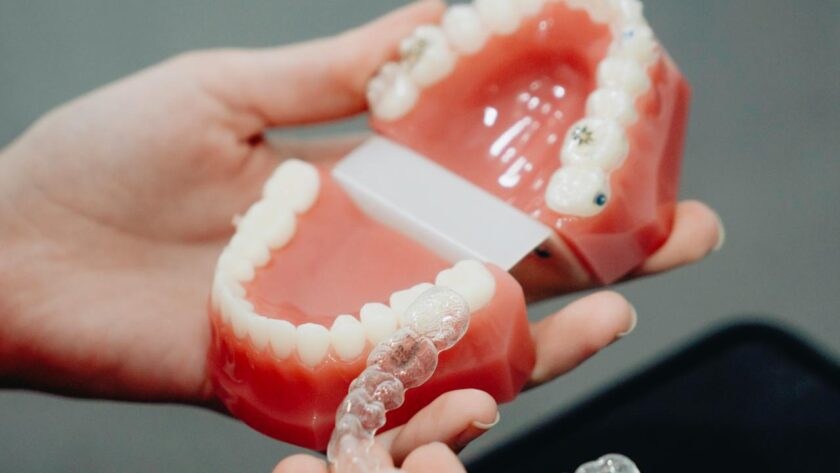Invisalign has revolutionized the world of orthodontics by offering a discreet and comfortable way to straighten teeth. This ultimate guide will walk you through everything you need to know about Invisalign—from how it works and its benefits to what you can expect during your treatment. Whether you’re just starting to explore your options or are ready to take the plunge, this guide is designed to help you make an informed decision with confidence.
What is Invisalign?
Invisalign is a popular teeth straightening treatment that uses clear plastic aligners to gradually shift the teeth into the desired position. Unlike traditional braces, which use metal brackets and wires, Invisalign offers a more discreet and comfortable alternative for achieving a straighter smile.
How Invisalign Differs from Traditional Braces
Invisalign aligners are virtually invisible, making them a preferred choice for individuals who want to straighten their teeth without drawing attention to their orthodontic treatment. The clear aligners are also removable, allowing for easy maintenance of oral hygiene and the ability to enjoy all types of food without restrictions.
Benefits of Choosing Invisalign for Teeth Straightening
Invisalign offers numerous advantages for teeth straightening. The custom-made aligner trays ensure a comfortable and precise fit, while the smooth plastic design minimizes gum and cheek irritation compared to traditional braces. Plus, the ability to remove the aligners for meals and dental hygiene makes Invisalign a convenient choice for many orthodontic patients.
How The Invisalign Treatment Process Works
Understanding the Invisalign treatment process can help you anticipate what to expect and ensure you’re prepared for each step along the way.
Initial Consultation and Assessment
The first step in the Invisalign treatment process is to schedule a consultation with a qualified orthodontist or dentist. During this visit, the dental professional will assess the patient’s teeth and discuss their treatment goals. X-rays, photographs, and impressions of the teeth may be taken to create a 3D image that will be used to develop a customized treatment plan.
Customized Treatment Plan and Aligner Fabrication
Following the initial assessment, your orthodontist will develop a custom treatment plan that outlines the gradual movement of your teeth. This plan ensures a steady, controlled realignment to reach your desired results. Advanced technology, like 3D imaging, is used to create precise, comfortable aligner trays for your treatment.
Wearing and Changing Aligners
Your Invisalign treatment includes a series of aligner trays, with each set worn for about two weeks. You should wear them most of the day, removing them only for eating, drinking, brushing, and flossing. After the designated time, you’ll switch to the next set, gradually guiding your teeth into alignment.
Monitoring Progress and Adjustments
Regular check-ups with your orthodontist or dentist ensure your Invisalign treatment stays on track. These visits allow your orthodontist to monitor progress and make adjustments to your treatment plan as needed. It’s also a chance to address any concerns and confirm that your teeth are aligning as intended for the best results.
Tips for Successful Invisalign Treatment
To make the most of your Invisalign treatment and achieve optimal results, it’s essential to follow a few key tips and best practices.
Proper Aligner Care and Maintenance
It is essential to maintain the cleanliness of the aligner trays by brushing them gently with a toothbrush and rinsing them in lukewarm water. Avoid using hot water, as it can warp the plastic material. Additionally, it’s important to store the aligners in their designated case when not in use to prevent loss or damage.
Managing Discomfort and Potential Challenges
Some discomfort or pressure may be experienced when starting a new set of aligners, but this typically subsides within a few days as the teeth adjust to the new position. If any sharp edges or irritation occur, the dental provider should be contacted for guidance.
Maintaining Good Oral Hygiene During Treatment
Regular brushing and flossing are crucial for maintaining good oral hygiene while undergoing Invisalign treatment. It’s important to clean the teeth and aligners after eating or drinking anything other than water to prevent staining or bacterial buildup.
Following Recommended Dietary Guidelines
While the aligners are removable, it’s recommended to minimize the time they are taken out to ensure the treatment progresses as planned. Avoiding sticky or hard foods can also help prevent damage to the aligner trays.
How to Achieve Long-Term Results with Invisalign
After completing the active phase of Invisalign treatment, you may be prescribed retainers to maintain the new position of your teeth, and it’s crucial to wear them as directed to avoid any relapse. Alongside wearing retainers, regular dental checkups and cleanings are essential to keep your teeth healthy and ensure your alignment remains stable over time. Additionally, adopting good habits—like avoiding teeth grinding, nail-biting, and using teeth as tools—will help preserve the results of your treatment and prevent unnecessary wear and tear.
Conclusion
Invisalign offers a convenient and discreet way to straighten teeth, providing numerous benefits and a straightforward treatment process. By following the tips for successful treatment and maintaining long-term care, individuals can achieve a confident and straighter smile with the help of clear aligners. Remember, a beautiful smile starts with proper dental care!



